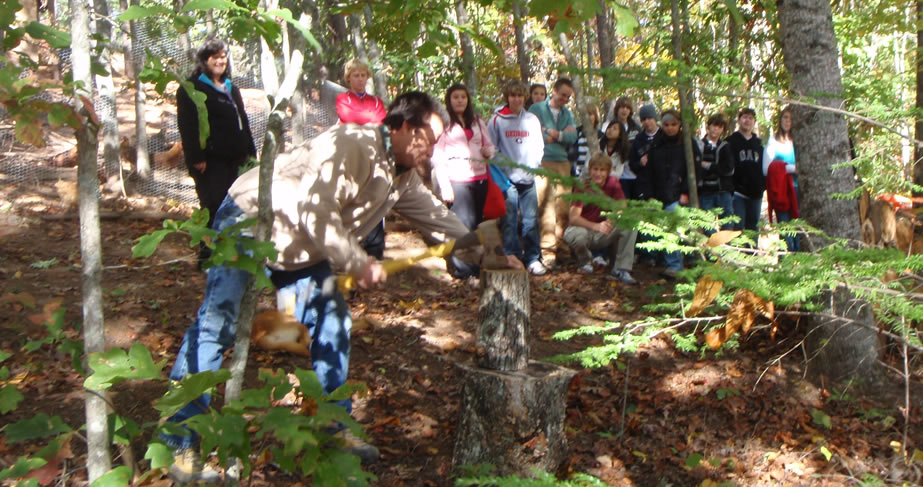
Living with the Land in the Southern Appalachian Mountains:
an Eighth Grade Field Trip to Revival Gardens and Katuah Construction
Rationale: In our highly-technolgical world, it seems odd to think that our increasingly convenient suburban lifestyles are depriving us of anything; but without the varied experiences of farm-life, students' background for learning is more limited than ever. It is becoming increasingly apparent that life in the country, enhanced with modern technology, can offer sophisticated approaches to solving some of the challenges of the global age: dependence on foreign oil, water shortages, and certainly, more quality food. Water and waste-water on a small family farm need not be trucked-off or pumped-out to be "disposed of" and "treated" far away. "Grey water," from baths, showers, sinks, and laundry waters surrounding trees and a garden. Kitchen scraps go to the chickens who turn it into fresh eggs. Land set aside for woodlands provides insight into the bigger picture of the regional ecology, its traditional role in providing clean water, wild foods, and fuel. Building designs that incorporate directional considerations like southern-exposure for passive solar power also increase energy effeciency and independence. Should the world economy take a downturn, a more localized, regionally-based economy can provide a kind of saftety net can provide a back-up source for quality food, water, and alternative fuels. No one can be (or should want to be), completely independent from the global economy, but the choices we make regarding where and how we live, what size house, and how the home interfaces with the land are important considerations if we want to nurture our economy and environment, not to mention our families and culture, into the future.
10AM to 1PM:
Bus arrives and parks at the back of Revival Gardens. Joe arrives on the tractor to meet the students, and introduce the garden, according to the current season -- late October (after first few frosts). We talk about the cold and the danger of frost to living things, including humans. Has anyone ever had frostbite? Students are surprised to find out that some plants are adapted to the cold, like plants in the cabbage family, including greens (collards, canola, kale, mustard), and brocolli. Its still not easy to grow plants in the winter, however; and even plants in the cabbage family are suseptible to frost and extreme drops in temperature. In a few minutes, we'll see some "row covers" we use to protect some of the cold-hardy plants from the frost. I ask the students to look at where the sun is rising and ask them what direction it is, and then what direction, or side of the mountain plants might grow the best in the winter here in the mountains. They have to think about it, but come up with the southern side of the mountain because they realize that the sunrise would not be reaching the north side of the mountain in the winter. I add that the eastern side of a mountain is also important for many plants to dry the dew on them first thing in the morning. If plants, especially fruit trees and grapes, remain wet in the morning, they are more suseptible to fungi and diseases, which are debilitating to many plants. Fruit crops on the wrong side of the hill would need more chemicals to combat fungus and disease. Animals benefit from having their buildings open to the south and east too! It warms them faster and we all like to be warmed-up after a long chilly night!
10:10 We proceed into the garden, while Joe explains that organic farmers attempt to use as many non-chemical approaches to raising vegetables as possible to make a crop. (Agricultural chemicals are derived from petroleum and the more chemical ferilizers you use, the more chemical insecticides you need because the petroleum fertilizers make plants that actually attract more insects.) The vines wer're at at are called "hardy kiwi" and they finally produced fruit this year after five years growing. Common kiwis, the larger ones with hairy skin, are a semi-tropical plant that don't grow where winter temperatures drop below freezing for more than a few days. Hardy kiwis are hairless and are about the size of table grapes. We will sample them at lunch. We proceed toward a bee-hive where the early morning sun is shining warmly. There is something in this box that need to be warmed-up by the sun before they can come out and get to work -- very important work to the crops in the garden. Students guess that they are honey bees. We open the top of the box and look at the frames were the bees make their hives to store their honey. Why do we need bees in the garden? A few students respond that they are needed to pollinate plants. I explain that male and female plants don't have any other way to reproduce effectively and they are dependent on bees. Some plants, like corn and most varieties of the "domesticated" plants are dependent on humans to plant them, and bees to pollinate them. A significant number of honey bees in the world are disapearing each year and scientists are theorizing that the extensive use of insecticides and monoculture (lack of diversity in plants as agriculture has gotten more and more focused on one crop) may be causing health problems that lead to malnutrition and disorientation (the bees get lost!).
10:20 We walk past some rows of dying vines on the ground. In between them are rows of red plastic, about three feet wide. I ask the students what they think the plastic is for; and they figure out that its for keeping weeds from growing-up between the rows of sweet potatoes (we will eat sweet potatoes at lunch). And what is plastic made from? Students answer, "petroleum." Right, so organic farmers use some materials made from petroleum. They try to avoid petroleum-based chemicals in the soil because it can harm the micro-organisms in the soil. I explain that the soil is full of important bacteria and enzymes that help the plants' roots get nutrients from the soil. Organically grown means, most of all, that the farmer attempts to cultivate soil that is rich in decomposing material and microorganisms (bacteria and fungi) that are beneficial to plant growth. The more raw material you till into the soil, the more benefit you get for your plants, if you can rotate the plants around to different ground every year. Most plants can't be grown well in the same soil every year because there are bacteria and insects that build-up in the soil that become more and more destructive to the same plant. In nature there is an order for plants and trees that take-over newly tilled soil (for example pine trees take over and then hardwoods replace them). Each plant is adapted and continues to adapt to the ever changing conditions of the region's ecology. In farming, humans attempt to order the plant growth to get a good harvest of plants by changing the location of the plants every year (crop rotation) and companion planting because some plants benefit by being next to certain plants that help them survive against bugs and diseases. We proceed to a patch of kale greens.
10:30 We look at some winter greens called Canola, a plant grown frequently in Canada because they are cold hardy and they produce a seed that can be pressed into cooking oil. Students pick leaves to taste. We will have some of these greens for lunch. We continue our walk toward the central herb garden where there are two kinds of chives that are still green and healthy. The flowers at the top of the chives are now dry and the mature seeds are visible in their place. Students ask if you can take some of the seeds home to grow these plants. You can but it takes over a year to grow them to maturity. We proceed to the river that borders the garden. We pass the irrigation pump that we use primarily to make sure the seed germinates and gets established after sowing. Seed is a significant expense and we can not afford to have to buy seed twice, especially when there is usually only a short window of time during which you can plant your crop when there is less resistance from diseases, insects, and temperature. Every plant is adapted to a unique set of variables with which farmers must consider even thought they must often plant more than once and in more than one location due to bugs, diseases, too much rain (which brings detrimental fungi and disease), or drought. There are many other factors that must be considered as well, including soil Ph, percentage of organic matter in the soil, and essential minerals like magnesium, calcium, phosphorus, and nitrogen.
10:40 After looking at the river and feeling how cold the water is in October, we move on to rows "covered" with, polyester sheets, another petroleum-based product that is stretched over knee-high hoops to protect some of the more cold-sensitive plants a little more frost protection through the winter nights. Plants like cabbage, broccoli, chinese cabbage, daikon, and lettuce grow faster when protected from the nightly frost in the winter. Who can think of any other petroleum-based products that we use in the garden? I start the tractor and someone guesses deisel fuel. We gather field corn from the patch of tall dried corn stalks. Many of the ears of the corn, now dry, hang upside down from the position they grow in when the honey bees shook pollen down from the tasles to the silk at the top of the ears. This position enables the husk of the corn to protect the kernels from the rain. In the old days, farmers cut the stalks at the base and gathered them together, leaving the ears dangling in this position while wrapping the stalks together to support each other in small islands in the field. We fill the loader of the tractor to the top with dried ears of field corn. This type of corn has been in my neighborhood for close to a hundred years and, Willy, the farmer who gave it to me, called it "mule corn" but its good for humans too. We'll be eating it in the form of corn-bread at the house for lunch.
10:50 We walk up the mountain to the house. Before going inside, we bring a bucket of weeds (an invasive plant called Amaranth that came from a load of chicken litter I put on the field one winter. This chicken litter must not have been fully composted because if it was, the weed seeds would have been sterile due to the high temperatures the compost produces. Amaranth is the worst weed we do battle with in the garden, but the chickens will eat it and our hope is that our goats will like it too when we introduce goats to the garden next spring. The plan is to rotate goats and chickens into the garden in areas that we have finished harvesting -- the collard greens in the late spring for example. Most of the students have never seen chickens come up to them expecting to be fed something from the garden. My wife, Sayuri brings out a pot full of kitchen scraps to give to the chickens, and some of the students give the chickens some of the dried corn they break off from the cob. Chickens prefer the corn more than anything! Students see that the chickens are a productive part of the farm, giving the family and customers eggs in exchange for the kitchen scraps, weeds, bugs, and feed we give them every day. We have about forty chickens and during their peak egg producing time during the year, they give over three dozen eggs a day. In the fall, when their bodies are developing new feathers (molting), their egg production drops off for a couple of months. They still eat the same amount of feed, however, and its not cheap!
Because its a cold day, we split a little firewood and carry it in the house. The southern Appalachian mountains are full of trees -- hardwoods (white, red, and black oak, hickory, black walnut, sweet gum, tulip poplar, to name a few) and softwoods (white and yellow pine and hemlock to name a few). The Cherokees called trees the tall people, and believed that they cared about humans because they gave them so much -- shade, building materials, fuel, nuts (a hundred years ago, before a fungus from Asia wiped them out, the very edible chestnut trees were the predominant hardwoods in the mountains!)

A small wood-stove provides plenty of heat in the winter on cloudy days and cold nights. This stove loads from the front and the side for convenience. The right side door is closest to the front door of the house. On winter nights, filling the stove at night before you go to bed gives you enough hot coals to last until morning.
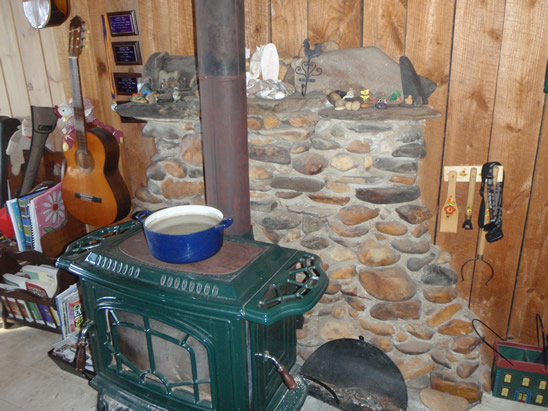
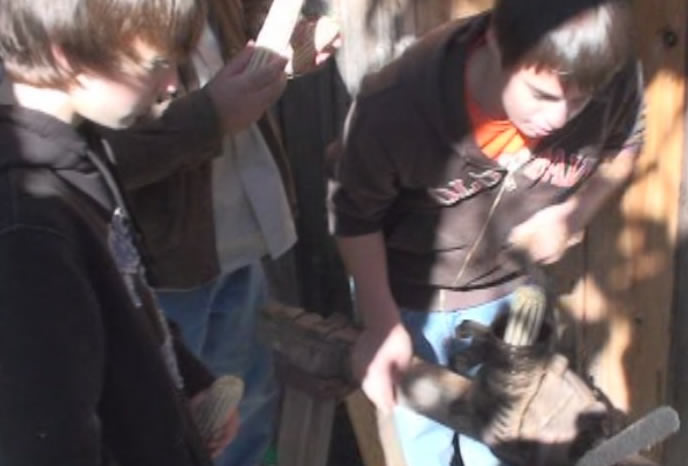 11:10 We go inside and settle down on a table on the deck to sample hardy kiwis and mountain well water. We each husk an ear of corn and take it to the "corn sheller" machine to turn the kernels off of the cob. There are other varieties of corn like sweet corn, the kind that doesn't make very good dried corn, but is as sweet as candy
during its "roasting ear" period in the summer. And then there's pop-corn corn which has a much smaller kernel than field corn but "pops" when its dried sufficiently and put in hot oil in a frying-pan. Don't forget to cover the pan and shake it while it pops!
11:10 We go inside and settle down on a table on the deck to sample hardy kiwis and mountain well water. We each husk an ear of corn and take it to the "corn sheller" machine to turn the kernels off of the cob. There are other varieties of corn like sweet corn, the kind that doesn't make very good dried corn, but is as sweet as candy
during its "roasting ear" period in the summer. And then there's pop-corn corn which has a much smaller kernel than field corn but "pops" when its dried sufficiently and put in hot oil in a frying-pan. Don't forget to cover the pan and shake it while it pops!

 11:30 After everyone is finished, we start lunch with a garden salad of "baby greens and daikon (Japanese radish). We have a summer vegetable soup with a tomato base one day and a butternut squash base the next day. Cornbread, made from the same corn we gathered in the field is the main course. Some students didn't know you have to grind the corn before you can make it into bread. One student wanted to bring home an ear of the dried corn so his mother could make some delicious corn bread for supper! We have a desert of butter cookies with chopped hemlock needles and drink apple juice. All coniforous trees are edible, but the hemlock is especially tasty. We use it in cookies to highlight the current plight of the hemlock tree that is threatened by an invasive insect that came over from Asia. It has already wiped out the hemlocks in the Shenandoa and Smoky mountains. Dahlonega hosts a Hemlock festival to bring attention to the current problem in hopes of raising money to combat the invasive insect with an Asian beetle that feeds exclusively on the invasive one. This year was the fourth year for the Hemlockfest and we have made hemlock cookies and tea the last three years. The hemlock tea that Socrates was forced to drink to commit suicide in ancient Athens is a different plant altogether. Its' called water hemlock and is related to the wild carrot.
11:30 After everyone is finished, we start lunch with a garden salad of "baby greens and daikon (Japanese radish). We have a summer vegetable soup with a tomato base one day and a butternut squash base the next day. Cornbread, made from the same corn we gathered in the field is the main course. Some students didn't know you have to grind the corn before you can make it into bread. One student wanted to bring home an ear of the dried corn so his mother could make some delicious corn bread for supper! We have a desert of butter cookies with chopped hemlock needles and drink apple juice. All coniforous trees are edible, but the hemlock is especially tasty. We use it in cookies to highlight the current plight of the hemlock tree that is threatened by an invasive insect that came over from Asia. It has already wiped out the hemlocks in the Shenandoa and Smoky mountains. Dahlonega hosts a Hemlock festival to bring attention to the current problem in hopes of raising money to combat the invasive insect with an Asian beetle that feeds exclusively on the invasive one. This year was the fourth year for the Hemlockfest and we have made hemlock cookies and tea the last three years. The hemlock tea that Socrates was forced to drink to commit suicide in ancient Athens is a different plant altogether. Its' called water hemlock and is related to the wild carrot.
 11:50 We discuss the factors that influence our descisions to live in one place or another, factors like working in the world economy and banks that give loans more easily for certain kinds of houses in suburban developments. We discuss my decision to move from the Atlanta suburbs where I attended school from the fifth through the twelfth grade. I tell them that when I was fourteen and fifteen years old I started taking trips to the mountains to go backpacking and canoe camping with my friends and I decided that this is where I wanted to live. I used the money I had saved for a car and made a down-payment on this land when I was sixteen. I knew there was something about rural life that I liked. When I was seventeen I started building the house, or cabin. The black oak tree that is still growing-up through a hole in the deck is the the one I climbed when I was exploring for places to build. My friends and I dug holes for a pole foundation that would eventually support the whole house and then be dug-out and replaced by a concrete foundation on which I am about to finish. The power company in Atlanta gave old telephone poles away for free if you hired someone with a dump truck to pick them up for you. I paid a dump truck driver a hundred dollars and he brought them all the way to the land from Atlanta for me. No matter where you decide to buy land to live, chances are you'll be within an hour or two from a major city somewhere, and that only impoves the chances that you can use recycled materials like telephone poles, doors, and windows, and just about any other building material you can think of. It also doesn't take a whole lot of committment of time to learn a trade like carpentry so that you'll at least be functional in building essential buildings on your land. I attended college while I was working on the land and learning a trade. I then went to live and work in Japan but kept paying on the land and eventually, after graduate school, returned to the land to raise my family.
11:50 We discuss the factors that influence our descisions to live in one place or another, factors like working in the world economy and banks that give loans more easily for certain kinds of houses in suburban developments. We discuss my decision to move from the Atlanta suburbs where I attended school from the fifth through the twelfth grade. I tell them that when I was fourteen and fifteen years old I started taking trips to the mountains to go backpacking and canoe camping with my friends and I decided that this is where I wanted to live. I used the money I had saved for a car and made a down-payment on this land when I was sixteen. I knew there was something about rural life that I liked. When I was seventeen I started building the house, or cabin. The black oak tree that is still growing-up through a hole in the deck is the the one I climbed when I was exploring for places to build. My friends and I dug holes for a pole foundation that would eventually support the whole house and then be dug-out and replaced by a concrete foundation on which I am about to finish. The power company in Atlanta gave old telephone poles away for free if you hired someone with a dump truck to pick them up for you. I paid a dump truck driver a hundred dollars and he brought them all the way to the land from Atlanta for me. No matter where you decide to buy land to live, chances are you'll be within an hour or two from a major city somewhere, and that only impoves the chances that you can use recycled materials like telephone poles, doors, and windows, and just about any other building material you can think of. It also doesn't take a whole lot of committment of time to learn a trade like carpentry so that you'll at least be functional in building essential buildings on your land. I attended college while I was working on the land and learning a trade. I then went to live and work in Japan but kept paying on the land and eventually, after graduate school, returned to the land to raise my family.

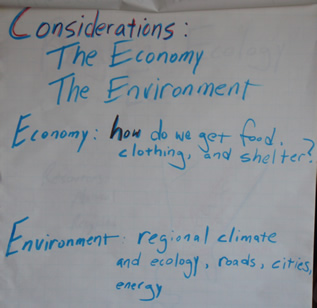
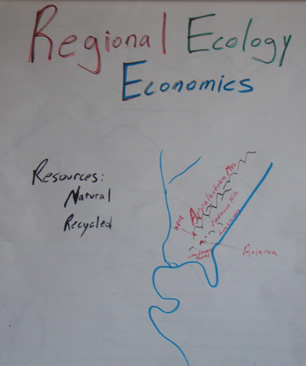
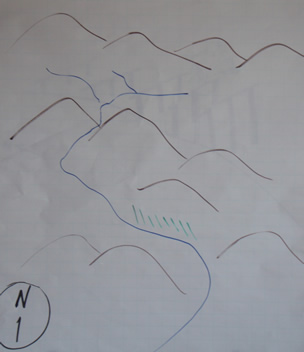
12:10 If you want to live in the country somewhere and really get to know the region and the people who live there, you might have to be able to ride-out storms in the world economy and it may require you to be able to do more than one thing to make a living. That's what I learned from people out here. No one does just one thing. They know at least a trade or two, they farm, and they have other projects the work on that sometimes brings other work. Jobs in large companies come and go, but if you have some useful skills, whether its writing, playing an instrument, or doing a trade, you'll have more opportunities to make a living and a better chance of staying on the land. And you don't need to go into debt buying a home that is more than you need. Hundreds of thousands of people in 2008 lost their homes because they bought a bigger home than they needed. Some of them might have been better off and more happy if they had more land and less home. We look at some of the visuals I made to get students thinking about the questions,
We are not accustomed to thinking about choosing a place to live based on the land on which we prefer to live. I chose northern Georgia, oringinally because it felt like a frontier to me, a place to explore through hiking and canoing, and even through meeting independent-minded rural people who knew how to survive in the country. Many people who live in the country and are devoted to their land must have several skills on which to rely to make a living. I learned farming, to save money on food, and to eat better food than you can buy in the stores; and I learned carpentry to be able to build my house and essential farm buildings like small barns and storage sheds. Many of these buildings can be build using pine 8" pine saplings that are growing on most mountain land in abundance. Learning to use a chainsaw, and axe, and a draw knife are some of the basics of living with the land in the mountains. You have to remember not to cut everything though. Harvest a minimum of what you need and leave the rest for future years. It's fun to see how the forest changes over the years. You'll learn a lot about how the trees interact together; and even the deer play a role in propogating some types of trees like persimons and sumac, two trees that produce food that you can enjoy in the fall. Sumac berries make a great "sun-tea" that's better than any cool-aid you can make, and persimons are a sweet creamy fruit after the frost softens and sweetens them in late October.
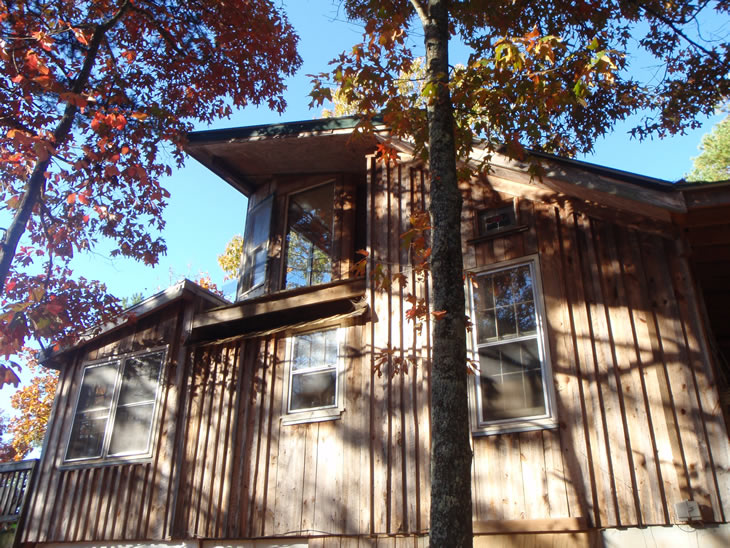
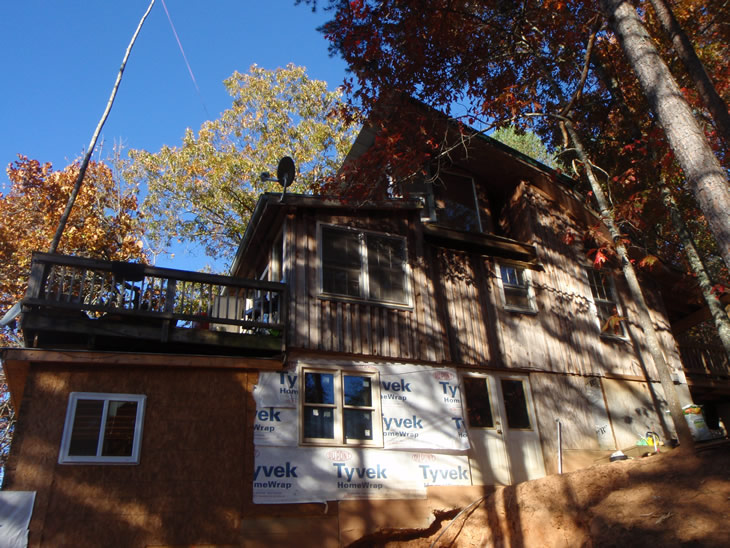

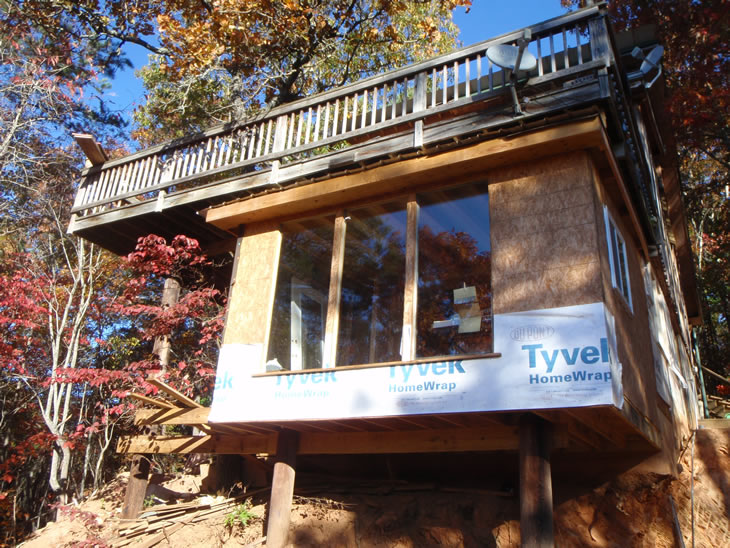
If you have built castles in the air, your work need not be lost; that is where they should be. Now put the foundations under them.
Henry David Thoreau
The original "cabin" rested on five rows of three poles. Years later, I dug-out a "step foundation" in between the poles,
stepping down the mountain to make space for rooms. During this time, I ran-accross the Thoreau quote about building
castles in the air and putting foundations under them later. That encouraged me to press-on with the more permanant
foundation, even though the 15 telephone pole foundation would have probably lasted me a lifetime. One of the reasons
for the upgrade was that banks would not give me a loan on the house without a concrete foundation.
Early-on, when you're young, you probably shouldn't go into debt to build a fancy house, so a
foundation from recycled power/telephone poles makes good sense and they provide flexibility for
building on a steep hillside. Post-hole diggers, some instant concrete and friends to help you carry and stand the heavy
poles in the holes is about all you need. I skinned four pine saplings and stood them up on four of the telephones to enable
the building of the sleeping loft first, before the rest of the building was done. There are usually plenty of small pine trees around
8 inches in diameter
that
make great building timbers for supporting the floor and roof in one, without the need for walls, until
winter comes. As you can afford it, you can build on to your loft and fill in the open spaces beneath while you're learning to
use tools of the trade. A little wood stove can easily heat your one room cabin, and you can dig an out house if you got enough
land for privacy. And don't forget a water barrel to collect rain from you roof for wash water. It took about 5 to 10 gallons of water a
week for drinking and cooking. You can easily haul this from someone else's house until you can afford a well of your own.
Take your baths in a nearby creek or river, or the college you are attending. Work on your degree while you build your house and learn a trade.
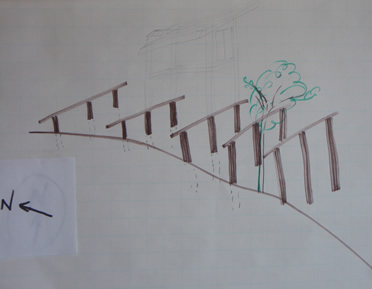
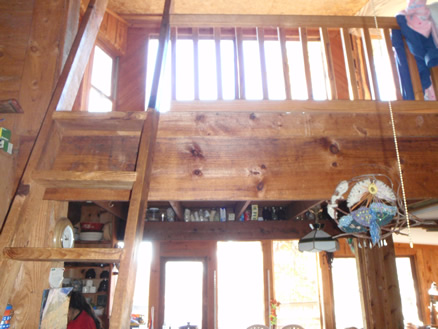

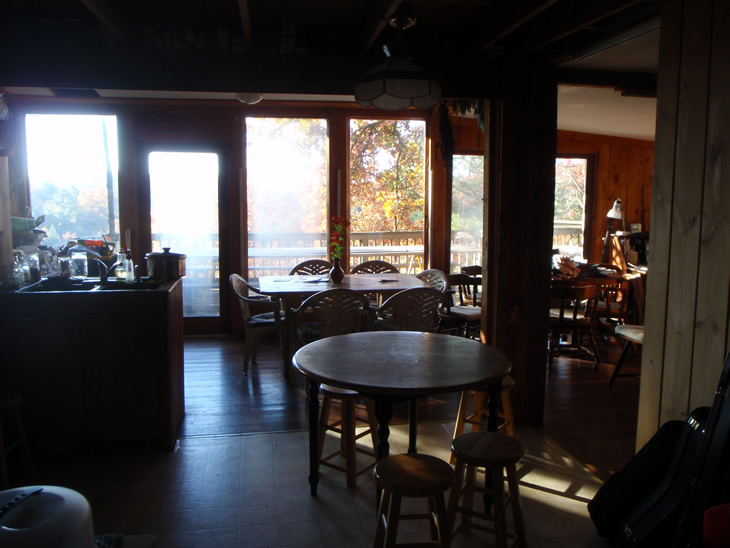
When you build anything, whether its your house or your barn, the direction you face the windows and doors will help make your house or barn a warmer place in the winter and a cooler place in the summer. If you have plenty of windows on the south side of your house, you won't need to use many other resources to heat your house in the winter, on sunny days at least! In the mountains of northern Georgia there is usually plenty of hardwood to burn at night and on cloudy days!
Review questions (learning objectives):
Learning Objectives:
1) Explain the significance of directions (north, south, east, and west) throughout the seasons on a small farm (garden, barns, and house) in the southern Appalachian mountains. Which side of a mountain do gardens, bees, and houses need to placed? (answer: south) How does an eastern facing slope help plants and animals? (answer: east to burn off the morning dew to provent deadly fungus and diseases)
2) Explain how gardening is possible year-round and what is the role of goats and chickens in the garden. What plants are adapted for growing in the winter? (answer: every plant is specially adapted to unique circumstances: some, like collards, kale, and canola are cold-hardy and others, like turnips, are less so) What plants are somewhat sensitive and need a "row cover" at night to protect them from frost? (answer: broccoli, cabbage, and radishes)
3) Give examples of how the region's environment (urban and rural) can provide reusable (recycled) and natural resources for small farm life? What materials from an urban environment can provide an alternative foundation for a mountainside building? (answer: telephone poles) What type of soft-wood tree is readily available in the southern Appalachian region for sawing into lumber and "peeling" for poles? (answer: pine trees)
4) Explain the signficance of petroleum in conventional and organic farming. Petroleum-based pesticides, herbicides and fertilizers are the centerpiece for conventional or organic farming? (answer: conventional farming) Diesel fuel, polyester row covers, plastic mulch film, and clear plastic greenhouses are an important component of conventional or organic farming? (answer: both)
5) Give examples of how land left in its natural state provides insight into the art of farming, water and soil quality. (answer: land left in its natural state shows how plants interact with one another, for example, pine trees preparing the ground for hardwoods, and other sybiotic relationships between animals/insects and plants, erosion control, and therefore, better water/soil quality)